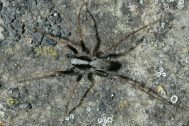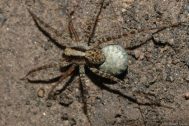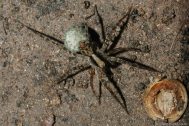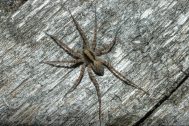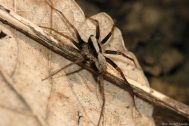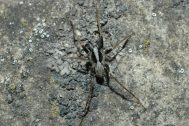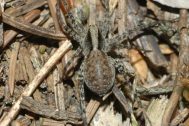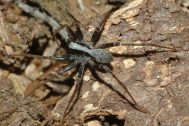| Nálezy podle období | |||||
|---|---|---|---|---|---|
| Lycosidae | 0-1900 | 1901-1950 | 1951-2000 | 2001+ | ∑ |
| Pardosa lugubris (Walckenaer, 1802) Není ohrožený | 3× | 1666× | 791× | 2460× | |
Pardosa lugubris (Walckenaer, 1802)
| České jméno | slíďák hajní |
|---|---|
| Stupeň ohrožení | Není ohrožený |
| Nálezy | 2460 nálezů, 358 kvadrátů |
| První nález |
1866, E. Bárta, Bárta 1869 |
| Poslední nález | 2025 , Ondřej Machač |
| Areál rozšíření | Palaearctic - Transp. |
| Fytogeografická oblast |
|
| Původnost stanovišť |
|
| Vlhkost stanovišť |
|
| Stratum |
|
| Osvětlení stanovišť |
|
| Hojnost výskytu |
|
| Nadm. výška | 150-1350 |
Literatura
Intense game grazing shapes epigeic spider communities of pedunculate oak Quercus robur plantations in anthropogenic environments
Game browsing affects nature conservation because the interests of hunters and gamekeepers often lead to high game stocking rates. However, the compositional effects of game browsing on invertebrates are insufficiently understood. We addressed the dynamics of epigeic spider communities in oak stands planted in newly formed anthropogenic environments under the facultative pressure of browsing game. The study site consisted of an open-cast lignite mine and an overburden deposit in NW Czechia. Using pitfall traps, we examined five habitat types (four transects per habitat type): Quercus robur stands ≥ 25 years of age, 12–24 years of age, and 0–2 years of age; Q. robur stands 12–24 years of age that were heavily damaged by game browsing; and sites subject to spontaneous succession for 12–22 years. We captured 9459 individuals from 134 spider species distributed unevenly across the examined habitat types. The young stands were dominated by Pardosa agrestis, Pardosa monticola, and Oedothorax apicatus, whereas Pardosa prativaga, Pardosa lugubris, Pisaura mirabilis, and Alopecosa cuneata dominated the old stands. The stands damaged by browsing had the highest species richness and were dominated by Alopecosa pulverulenta, Xerolycosa miniata, Alopecosa cuneata, and Trochosa ruricola. All the oak stands were rich in threatened species, with most (26) found in habitats damaged by browsing, whereas the youngest stands hosted the lowest number of threatened species (11). The species dominating old stands still included species that prefer greater canopy openness, such as Pardosa lugubris, whereas numerous species of central European climax oak forests were lacking. In conclusion, we identified oak stands heavily damaged by game browsing as a unique environment that shapes the community of epigeic spiders and that differs from epigeic spider communities of oak stands of various ages and those colonizing areas that are allowed to undergo spontaneous succession.
Vliv intenzity hospodaření při obnově dubových porostů v oblasti soutoku Dyje a Moravy na diverzitu pavouků (Araneae)
V této diplomové práci byla zkoumána intenzita hospodaření (přítomnost mechanické přípravy půdy) pasek po vytěžení porostu a její vliv na společenstva pavouků. Pro výzkum bylo vybráno 10 ploch, které byly rozdělené na 5 ploch intenzivně obhospodařovaných a 5 ploch extenzivně obhospodařovaných. Na každé z ploch byl umístěn odchytový transekt zemních pastí. Sběry probíhaly v datech: 18. 05. 2021, 17. 06. 2021, 19. 07. 2021, 19. 08. 2021, 01. 10. 2021. Celkem bylo odchyceno 7001 jedinců patřících do 16 čeledí a 85 druhů z toho 12 druhů spadalo do Červeného seznamu chráněných druhů v České republice. Nejhojnějším druhem byla Pardosa lugubris a z druhů z Červeného seznamu Trochosa spinipalpis. Nejpočetnější čeledí zjištěnou v rámci výzkumu byli zástupci čeledi Linyphiidae. Primárně v rámci výzkumu za pomocí zemních pastí byli odchyceni jedinci se strategií lovu ground hunters. Byla ale také přítomna celá řada síťových druhů. Počet druhů byl signifikantně vyšší na plochách extenzivně obhospodařovaných bez mechanické přípravy půdy. Ochranářská hodnota a početnost vzácných a ohrožených druhů byla také výrazně vyšší na plochách pod extenzivním hospodařením. Dále bylo zjištěno, že vliv hospodaření neměl vliv na celkovou početnost pavouků. Mezi významné faktory ovlivňující druhovou kompozici pavouků patřila vegetační pokryvnost a přítomnost drobných zbytků dřeva pokrývající půdní povrch. Dle výsledků lze konstatovat, že extenzivní způsob hospodaření má pozitivní vliv na pavouky. Proto tento typ hospodaření doporučuji jako vhodný způsob, který by se dále mohl využívat při obnově dubových porostů v oboře Soutok, případně i na jiných územích s cennými lužními porosty.
Contact exposure to neonicotinoid insecticides temporarily suppresses the locomotor activity of Pardosa lugubris agrobiont wolf spiders.
Exposure to numerous chemicals disrupts the spiders’ locomotion. Spiders, particularly epigeic spiders, are dependent on their locomotory activities to search for prey, hide from their enemies, and perform sexual reproduction and subsequent parental care. Among the best-known compounds that inhibit the locomotion of arthropods are neonicotinoids. Despite spiders are less affected by the neonicotinoids than insects due to the sequence differences in their acetylcholine receptors, they are not resistant to these compounds. We hypothesized that acute exposure to a broad spectrum of neonicotinoids suppresses the traveled distance, mean velocity, and maximum velocity in epigeic spiders. As a model species, we used adults of Pardosa lugubris. We tested commercial formulations of thiamethoxam, acetamiprid, and thiacloprid. We tested each of the neonicotinoids in the maximum and minimum concentrations recommended for foliar applications. We applied them under controlled conditions dorsally by spraying them directly on the spiders or exposing the spiders to the tarsal contact with neonicotinoid residues. Control groups consisted of 31 individuals; treated groups consisted of 10–21 individuals. We found that a broad spectrum of neonicotinoids temporarily suppresses the traveled distance in epigeic spiders. At 1 h after application, all the three tested neonicotinoid insecticides induced declines in the traveled distance, but this effect mostly disappeared when tested at 24 h after the application. The decrease in the traveled distance was associated with substantial temporary decreases in the mean and maximum velocities. Despite differences among modalities, all three insecticides caused multiple adverse effects on the locomotory parameters in any tested concentrations. It remains to test what would be the lowest safe concentration for the chronic exposure to neonicotinoids in epigeic spiders.
Subletální efekty insekticidů neonikotinoidů na migrační potenciál pavouků
Důvodem používání pesticidů je hubení organismů způsobujících škody (tzv. škůdci) na různých plodinách a díky tomu zabránit případným ztrátám na úrodě. Jejich nežádoucím účinkem je negativní dopad na necílové organismy.
Předložená diplomová práce je zaměřena na vliv neonikotinoidů na bezobratlé živočichy, a to konkrétně na pavouky. Jejím hlavním cílem bylo zdokumentovat jejich vliv na behaviorální parametry ovlivňující migrační schopnosti, jako jsou lokomoce a tendence k šíření pomocí větru (tzv. ballooning). Práce porovnává vliv neonikotinoidů na modelové druhy, Pardosa lugubris (Walckenaer, 1802) a Phylloneta impressa (L. Koch, 1881) s různým způsobem lovu kořisti a srovnává u nich vliv na adultní a nymfální stádia. V laboratorních podmínkách byly na pavouky aplikovány pesticidy Actara ® 25 WG, Biscaya ® 240 OD, Confidor ® 200 OD a Mospilan ® 20 SP a byl testován jejich účinek při rozdílných koncentracích a různých způsobech aplikace.
Největší dopad na pavouky měl přípravek Confidor. Měl jednoznačně nejvýraznější negativní vliv na mobilitu a tendenci k šíření pomocí větru pavouků. Letální účinky způsobily neonikotinoidy u nymfálních jedinců Pardosa lugubris, a to zejména přípravek Confidor (u tarzální aplikace dokonce i 100% úmrtnost). Během pokusu studujícím vliv na lokomoci u adultních jedinců Pardosa lugubris bylo zjištěno, že došlo po 24 hodinách k výraznému odeznění paralýzy způsobené neonikotinoidy.
Epigeic spiders from oak-hornbeam woodland in the Děvín National Nature Reserve (Czech Republic).
Data on the spider fauna from the forest ecosystems of the Děvín National Nature Reserve (South Moravia, Czech Republic) are presented. The research was carried out on 15 randomly chosen research plots in oak-hornbeam forest stands within different management regimes. Spider sampling was done by pitfall trapping from May to October 2016. Overall, 3683 adult spiders belonging to 22 families, 70 genera and 116 species were collected. The families Linyphiidae, Lycosidae, Gnaphosidae and Thomisidae exhibited high species richness. The most abundant species were Pardosa lugubris (Walckenaer, 1802) and Trochosa terricola Thorell, 1856. Faunistically remarkable species were Atypus piceus (Sulzer, 1776), Drassyllus villicus (Thorell, 1875), Gnaphosa montana (L. Koch, 1866), Panamomops affinis Miller & Kratochvíl, 1939 and Walckenaeria monoceros (Wider, 1834). The record of Gnaphosa montana is one of the first accounts of this psychrophilic spider from European lowlands. Of the identified species, 23 are listed in the Red List of Threatened Species in the Czech Republic (EN – 1 species, VU – 12 species, LC – 10 species).Synergistic effects of glyphosate formulation herbicide and tank-mixing adjuvants on Pardosa spiders.
Glyphosate-based herbicides are the world’s most consumed agrochemicals, and they are commonly used in various agroecosystems, including forests, as well as in urban zones and gardens. These herbicides are sold as formulations containing adjuvants. Other tank-mixing adjuvants (most often surfactants) are commonly added to these formulations prior to application. According to the manufacturers of agrochemicals, such tank mixes (as these are known in agronomic and horticultural practice) have modified properties and perform better than do the herbicides as used alone. The effects of these tank mixes on the environment and on beneficial arthropods are almost unknown. Therefore, we studied whether a herbicide formulation mixed with adjuvant has modified effects on one of the most common genera of ground-dwelling wolf spiders vis- a-vis the herbicide formulation and adjuvants themselves. Specifically, we studied the synergistic effect in the laboratory on the predatory activity (represented by the number of killed flies) of wolf spiders in the genus Pardosa after direct treatment using the glyphosate-based herbicide formulation Roundup klasik Pro ® , Roundup klasik Pro ® in a mixture with the surfactant Wetcit ® , Roundup klasik Pro ® in a mixture with the surfactant Agrovital ® , and the surfactants alone. We found that pure surfactants as well as herbicide-and-surfactants tank mixes significantly decrease the predatory activity of Pardosa spiders in the short term even as Roundup klasik Pro ® did not itself have any such effect. Our results support the hypothesis that plant protection tank mixes may have modified effect on beneficial arthropods as compared to herbicide formulations alone. Therefore, testing of pesticide tank mixes is highly important, because it is these tank mixes that are actually applied to the environment.Epigeic Spiders from Lowland Oak Woodlands in the South Moravia Region (Czech Republic).
This paper presents spider faunistics from abandoned coppice oak forest stands located along the South Moravia region. Spiders were collected from May to July 2012 by pitfall trapping at eight different localities. We collected 1945 adult spiders representing 20 families, 53 genera, and 90 species. More than one-third of all the species are known to be xerothermophilous with ecological restrictions to open and partly shaded habitats such as forest-steppe and sparse forests which belong to endangered habitats along central Europe. The most abundant species were Pardosa alacris, Pardosa lugubris and Arctosa lutetiana from the family Lycosidae. In the surveyed area, 24 species were found listed in the Red List of Threatened Species in the Czech Republic (CR – 1 species, EN – 2 species, VU – 15 species, LC – 6 species). In general, we discovered a substantially diversified spider community with a large presence of rare and endangered species characteristic for open and xeric habitats.
Fotografie
Statistiky
Dle měsíce v roce
Dle nadmořské výšky
Dle metody sběru (2459 použitých nálezů)
| Pardosa lugubris (Walckenaer, 1802) ES | Samci | Samice | Mláďata | Nálezy |
|---|---|---|---|---|
| Individuální sběr | 313 | 351 | 19 | 259 |
| Smyk | 53 | 78 | 1 | 47 |
| Zemní past | 9140 | 4000 | 1037 | 1652 |
| Neurčeno | 748 | 828 | 3 | 420 |
| Prosev | 32 | 46 | 3 | 32 |
| Žlutá miska | 4 | 13 | 0 | 9 |
| Fotografie | 0 | 2 | 0 | 1 |
| Sklepávání | 206 | 114 | 1 | 22 |
| Eklektor | 16 | 2 | 33 | 17 |
| Samci | Samice | Mláďata | Nálezy |
Dle biotopu (2460 použitých nálezů)
| Pardosa lugubris (Walckenaer, 1802) ES | Samci | Samice | Mláďata | Nálezy |
|---|---|---|---|---|
| Vrbové křoviny - vlhké (vrbové) křoviny | 2 | 4 | 0 | 5 |
| Lužní lesy nížin | 875 | 272 | 38 | 63 |
| Suché lesní lemy | 53 | 4 | 0 | 10 |
| Stepi, vřesoviště, písčiny | 11 | 4 | 0 | 2 |
| Paseky | 425 | 192 | 3 | 89 |
| Travnaté stepi | 2 | 0 | 0 | 2 |
| Rákosiny a orobincové porosty stojatých vod | 86 | 11 | 0 | 14 |
| Neurčeno | 1801 | 1718 | 700 | 816 |
| Lesy | 55 | 39 | 1 | 76 |
| Jasanoolšové lemy vodotečí | 27 | 9 | 0 | 2 |
| Kamenolomy | 244 | 85 | 3 | 45 |
| Luční ostřicové mokřady | 4 | 7 | 0 | 6 |
| Těžebny písku a jiných nezpevněných hornin | 29 | 67 | 0 | 16 |
| Mokřady | 35 | 2 | 0 | 21 |
| Výsadby listnáčů | 283 | 323 | 0 | 14 |
| Lesostepní doubravy | 47 | 156 | 11 | 27 |
| Skalní stepi na jiných horninách | 1 | 0 | 0 | 1 |
| Suché doubravy | 562 | 190 | 23 | 80 |
| Suché louky | 54 | 67 | 1 | 30 |
| Jeskyně | 1 | 0 | 0 | 1 |
| Nehluboké podzemní prostory (pukliny, půdní horizonty) | 0 | 1 | 0 | 1 |
| Louky | 95 | 136 | 0 | 38 |
| Dubohabřiny | 79 | 101 | 3 | 19 |
| Suťové a roklinové lesy | 37 | 3 | 0 | 15 |
| Křoviny | 28 | 7 | 0 | 3 |
| Kosodřevina | 0 | 0 | 0 | 1 |
| Louky | 86 | 23 | 0 | 17 |
| Horské smrčiny | 20 | 10 | 2 | 16 |
| Mezofilní louky | 36 | 27 | 0 | 18 |
| Mokré louky | 375 | 48 | 0 | 34 |
| Bučiny nižších poloh | 195 | 52 | 2 | 50 |
| Rašeliniště | 119 | 57 | 0 | 49 |
| Zahradnicky utvářené zahrady a parky | 30 | 6 | 1 | 5 |
| Reliktní bory na skalách | 39 | 13 | 3 | 19 |
| Podmáčené smrčiny | 11 | 5 | 0 | 4 |
| Horské bučiny | 64 | 27 | 11 | 27 |
| Lesy | 1536 | 437 | 90 | 190 |
| Antropická společenstva | 1 | 2 | 1 | 3 |
| Železniční náspy | 0 | 0 | 1 | 1 |
| Výsadby jehličnanů | 815 | 406 | 179 | 140 |
| Vřesoviště nižších poloh | 9 | 6 | 0 | 3 |
| Lesní okraje | 471 | 244 | 16 | 75 |
| Xerotermní travinobylinná společenstva | 46 | 68 | 0 | 36 |
| Ruderály | 175 | 47 | 0 | 14 |
| Suché křoviny | 66 | 24 | 0 | 18 |
| Vlhké doubravy | 0 | 1 | 0 | 1 |
| Skalní stanoviště | 0 | 2 | 0 | 1 |
| Ovocné sady s luční vegetací | 309 | 61 | 0 | 37 |
| Bahnité břehy | 5 | 0 | 0 | 2 |
| Kamenité břehy potoků | 0 | 1 | 0 | 1 |
| Mokřadní olšiny | 350 | 43 | 1 | 33 |
| Ostřicové porosty stojatých vod | 3 | 1 | 0 | 3 |
| Okraje silnic | 78 | 48 | 0 | 10 |
| Skalní stepi na vápenci | 37 | 20 | 0 | 8 |
| Rašelinné bory | 107 | 39 | 5 | 36 |
| Pastviny | 4 | 1 | 0 | 4 |
| Břehy tekoucích vod | 15 | 13 | 0 | 19 |
| Ovocné sady a vinohrady | 2 | 0 | 0 | 2 |
| Močály | 13 | 10 | 0 | 14 |
| Kamenité suti nižších poloh | 15 | 25 | 0 | 21 |
| Písčiny | 5 | 26 | 0 | 8 |
| Vlhké lesní lemy | 29 | 2 | 0 | 3 |
| Bylinné porosty břehů | 2 | 8 | 0 | 6 |
| Těžební jámy | 0 | 2 | 0 | 1 |
| Úhory | 4 | 3 | 0 | 4 |
| Štěrkové břehy řek | 0 | 1 | 0 | 2 |
| Haldy a výsypky | 4 | 1 | 0 | 11 |
| Přirozené lesy | 14 | 11 | 0 | 11 |
| Stinné skály nižších poloh | 264 | 87 | 0 | 32 |
| Louky a pastviny | 1 | 2 | 0 | 3 |
| Porosty borůvek | 119 | 62 | 0 | 22 |
| Lesy vyšších poloh a strmých svahů | 5 | 2 | 1 | 8 |
| Lesní cesta | 10 | 10 | 0 | 7 |
| Slaniska | 2 | 3 | 0 | 2 |
| Stojaté a pomalu tekoucí vody | 59 | 31 | 0 | 3 |
| Acidofilní bory | 65 | 12 | 0 | 16 |
| Ostatní pole | 5 | 0 | 0 | 5 |
| Písčité břehy | 11 | 2 | 0 | 4 |
| Polní biotopy | 44 | 4 | 0 | 2 |
| Horská vřesoviště | 1 | 3 | 0 | 1 |
| Skalní a suťové biotopy | 0 | 0 | 1 | 1 |
| Samci | Samice | Mláďata | Nálezy |








